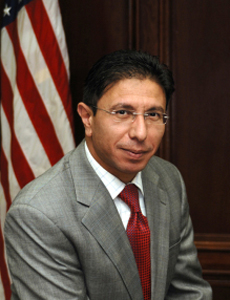Safety Research
Investing in a Safer Future

The Ohio Bureau of Workers’ Compensation made plenty of headlines with its billion-dollar rebates to employers. But few are aware of how the BWC is also giving back to its employees — by investing heavily in their long-term health and safety.
Part of that effort is the establishment of a research grant program, funding short-term projects that identify practical solutions to workplace hazards.
The BWC created partnerships with educational and research facilities across the state in an effort to find solutions for some of the most intractable worker health and safety problems.
“I wanted to get on the offensive side of safety and not just respond to accidents or injury types,” said former BWC Administrator and CEO Stephen Buehrer, who launched the research grant program.
“We believe these dollars are well invested in fostering research at world class institutions that could shed light on how injuries may be prevented in the future,” said the BWC’s current Administrator and CEO, Sarah Morrison.
“There is no place better than Ohio to conduct innovative research that could have an impact in workplaces across the country.”

Sarah Morrison, administrator and CEO, Ohio Bureau of Workers’ Compensation
The BWC sent out an RFP to research institutions throughout Ohio, seeking projects that could be completed in 12 to 18 months within a budget of $250,000. With input from the National Institutes for Occupational Safety and Health, they ultimately selected nine projects to fund, for a total just topping $2 million.
“These researchers are working directly with employers in Ohio, and we expect that there will be some direct benefit in preventing occupational injuries and illnesses as a result of [these projects],” said Abe Al-Tarawneh, BWC’s superintendent of the Division of Safety and Hygiene.
In addition, he said, each research team will disseminate its findings, results and recommendations, and make them available to employers throughout their respective industries.
Focus on Health Care
A sizable chunk of the $2 million for research was earmarked for projects related to health care fields. Injuries to health care workers, particularly those working in long-term care facilities, are of grave concern in Ohio and nationwide. Ohio has approximately 1,000 nursing homes, serving more than 80,000 residents.
“When we put out the request for proposal, addressing the health care industry was a priority,” said Al-Tarawneh.
Two of the selected proposals target safe patient handling practices. Al-Tarawneh said that in many cases, even in facilities that have sufficient patient handling equipment, workers tend not to use it because they perceive that it will slow them down or be inefficient.
A $250,000 grant to the University of Cincinnati will enable researchers to study the application of a training model that has been used extensively in Europe, particularly in the UK, with strong results. The model ties together cultural and behavioral issues, with a focus on hazard awareness and planning.
“They’re going to take it and essentially redesign it in a way that matches the standards that we have for health care in Ohio, and they’re applying it with 30 different nursing homes in the state,” said Al-Tarawneh.
Researchers will assess the existing training and equipment at those facilities, and customize the new training module for each one. They will then administer the training to employees at every facility, and follow up in six months to assess the effectiveness of the training. Based on those assessments, they’ll provide a new set of recommendations.
The resulting training program will be made available online.
Cleveland State University College of Science and Health Professions will also receive $244,000 to help faculty from four disciplines at CSU develop an innovative approach to prevent back injuries among nurse aides.
The Case Western School of Medicine will receive $250,000.00 to study the development of a Total Worker Health approach to addressing the socioeconomic factors impacting worker health and safety, particularly low-wage and job-insecure employees working in long-term health care facilities.
“Low wage and job-insecure employees tend to have a higher rate of occupational injuries and they tend to [have poor] health care and more prevalent chronic health issues,” said Al-Tarawneh.
Case Western researchers will work with 10 or 12 groups of people, providing training on healthy behaviors. They’ll follow up over the course of a year, and assess progress via an app designed for the purpose.

Abe Al-Tarawneh, chief of safety and hygiene, Ohio Bureau of Workers’ Compensation
Bowling Green State University’s Psychology Department was awarded a $250,000 grant for research into preventing injuries, assault and abuse of nurse aides working in long-term residential settings.
The project will target nurse aides in four facilities, implementing mindfulness-based interventions. Researchers will teach employees to use mindfulness techniques to handle the stressors of their jobs.
“There is a direct association between the job demands and the rate of injury,” said Al-Tarawneh. “So if you get workers to better understand how to cope with the stresses of their job demands, you can improve their well-being, which will result in reducing the propensity for them to get injured.”
Part of the project will involve teaching workers to use the same mindfulness techniques to de-escalate situations that lead to assault or abuse by residents.
“When you think about these different projects, each of them handles the [industry] from a different angle,” said Al-Tarawneh.
“So in two or three years, when our consultants are working with a health care facility or a nursing home, they’re going to be able to provide them with better training modules, with better understanding of the issues, with better tools so they can engage their employees and empower them.
“We’re hoping by the time we’re done that it will benefit the industry across the country.”
Benefits for Numerous Industries
Other BWC grants are exploring a variety of challenges for workers and employers.
Using sensors embedded in the insoles of shoes, researchers are recording data on balance and gait, and relating it to specific tasks, to assess at what point being unbalanced results in a fall. In the future.
The Ohio University College of Engineering and Technology received $245,000 to measure the impact of integrating safety and ergonomics into lean and Six Sigma processes already in place at Ohio manufacturers.
“One of the things that’s happened over the years of introducing lean concepts and Six Sigma concepts in manufacturing as well as other industrial sectors is they tend to eliminate waste,” said Al-Tarawneh.
“That can result in improving safety for employees, but it can also result in improving productivity to a level that sometimes employees cannot keep up with. So the idea is to bring in ergonomic concepts and embedding them into Six Sigma and lean manufacturing concepts.”
Researchers are working with 15 manufacturing firms across Ohio, stratified between small and large firms, and a final report will be available across the country.
The Case Western School of Engineering received a $250,000 grant to study the prevention of slips, trips and falls using wearable technology.
Using sensors embedded in the insoles of shoes, researchers are recording data on balance and gait, and relating it to specific tasks, to assess at what point being unbalanced results in a fall. In the future, explained Al-Tarawneh, “the system can communicate via something like an iWatch and warn the person that the way they’re doing things will result in slipping or tripping.”
Ohio State University has been awarded three grants totaling $577,595 to study diverse areas.
OSU’s Department of Integrated Systems Engineering is using a wearable quantifying tool called a lumbar motion monitor to gather real data about the forces exerted on the spine during pushing and pulling tasks.
Researchers will be developing a web-based tool that employers can use to assess the pushing and pulling tasks used at their facilities.
Subjects will simulate tasks common to workers in various industries, said Al-Tarawneh. The lumbar motion monitor and 42 sensor cameras are used to establish every movement in every direction to establish the stress of each movement on the spine. The results are compared to injury threshold data and will be used to create streamlined ergonomic standards for pushing and pulling tasks.
“It’s an amazing project,” said Al-Tarawneh. “It’s going to be an excellent advancement in the science.”

Stephen Buehrer, former administrator and CEO, Ohio Bureau of Workers’ Compensation
Researchers will be developing a web-based tool that employers can use to assess the pushing and pulling tasks used at their facilities.
In the lab next door, researchers are studying powered torque wrenches, and the impact of the force and vibration of torque tools on the hands and arms of the user.
“Those forces, over time, can be really detrimental to the tissues and the nerves of the worker,” said Al-Tarawneh. “There is no specific standard for these torque tools to account for how the force of the tool transfers to the body of the user.”
The team will develop a dynamic rig for assessing powered torque tools as they are brought to market. Industry partners include Stanley Assembly Technologies, Honda North America, Inc. and General Motors.
A third project at OSU involves hazards in grain bin facilities on Ohio farms, assessing the training and PPE provided to workers, and identifying gaps that can be addressed. Al-Tarawneh said this project is an important way that BWC can reach out and work with smaller farmers to help prevent the kind of injuries that are sometimes overlooked.
“We’re going to fund this kind of thing every year,” former Administrator Buehrer told Risk & Insurance during a September 2015 interview.
“Our hope is that each year we’ll be rolling out a half dozen to a dozen sets of results that we can share with employers. Ohio BWC considers it a key part of its mission to take on some of the problematic workers’ comp challenges and really get ahead of the issues rather than just reacting to the injury type.”










